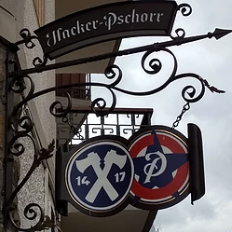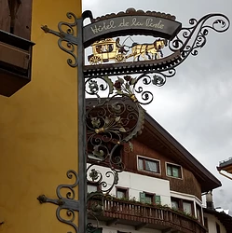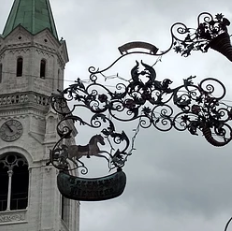What do you do if it is rainy and cold while visiting the Dolomites? You envisioned your trip months or weeks ahead but all the careful planning cannot predict the weather. In addition, if it is early in the season there are other surprises awaiting. A few things it would be helpful to know before finalizing your itinerary in the area when traveling in the spring.

Limited lodging
Traveling in early June in the Dolomites in Veneto can certainly be beautiful. It is not crowded; in fact, schools are not over yet. Being late spring, it is not considered high season, thus prices for lodging are still decent. However, June 2 is an holiday in Italy and if it falls close to a weekend then it may be harder to find a place to stay. Keep this in mind and act accordingly!
In addition to the holiday factor, being early in the season may actually be an issue when it comes to booking your hotel, B&B, or cabin. Over night stay facilities may not be open yet thus your options for lodging suddenly narrow - reducing also the list of towns and villages where you may find accommodations. Being flexible is key!

Due to the previously described scenario we ended up staying in a B&B in Pieve di Cadore. We were lucky since B&B Cristina was a great bed and breakfast situated in the center of town with its own parking. Pieve di Cadore turned out to be a good location after all thanks to its proximity to the Three Peaks Wildlife Park (Parco Naturale Tre Cime - UNESCO natural heritage site) and other well known hiking areas and vacationing towns. Antelao Mountain (Monte Antelao) has beautiful trails; the hike to Rifugio Antelao starts from the village of Pozzale, 2.5 km above Pieve di Cadore. Lake Misurina and Cortina d'Ampezzo are also two locations not too far and popular among visitors. If you have time and can drive north on highway SS51, two must-see picturesque villages are Dobbiaco (Toblach) and Sesto (Sexten), located in the province of Bolzano in South Tyrol. In this area of Trentino Alto Adige (the bordering region with Veneto) there are two official languages, Italian and German since you are very close to the border with Austria.
Closed mountain huts

We chose to go to the Dolomites in the province of Belluno because of the amazing natural parks, hikes, and alpine scenery in the area. There are multiple hikes among which you can choose based on difficulty level; from the most extreme to the mountain stroll with your kids. Besides, if you are interested in history, particularly in WWI, the Cadore's area with its surrounding mountains was a battlefield from 1915 to 1917. Therefore, it is possible to see remnants of the war along some of the trails. Dolomiti.org provides exhaustive information about trekking, climbing, hikes, and walks. Furthermore, B&B hosts are usually extremely knowledgeable about trails and hikes. Living in the area, they have hiked a great deal of trails making them experienced hikers and mountaineers.

The motive of our trip was to enjoy the parks but the weather did not cooperate making it challenging to actually hike. In addition to rain, low clouds and temperatures, it did not help that mountain huts (rifugi) were closed. The season had not started yet - rifugi open around June 10. The purpose of rifugi is to provide shelter in case of bad weather, and a place to rest. Not being able to rely on them made it a little more challenging especially when hiking with a child. Despite such inconveniences we spent three days in the area. We stayed active as much as we could but we were not able to see the surrounding alpine scenery. Only for a few moments when the wind was clearing the valleys. Consequently driving from-and-to our destinations did not give us a chance to get a sense of what the area really looks like.
Traffic and parking

In the Cadore's area there is only one main road, SS51 that allows you to travel on the western side of the Three Peaks Wildlife Park. It leads north to Dobbiaco and south to Venice through the fast toll highway A27. North of Pieve di Cadore it becomes SS52 and it goes around Tre Cime on the eastern side toward Dobbiaco. Both SS51 and SS52 are two-lane winding roads, used by both visitors and locals alike. Semi-trucks and big tour buses travel on this roads as well, meaning that it may take a while to cover short distances. Traffic may significantly slow down your commute even though in the spring it is not as bad as in the winter or summer.
Another variable that may affect your stay in the area is limited parking. It is challenging to park in small towns; free public and street parking is tight. That is why it is important that your lodging offers private parking. Sometimes parking is absent at trail-heads, thus the option is to park somewhere down in the village or along the road. Popular destinations charge for parking; at Tre Cime it costs 25 Euros to park your car in order to have close access to hike trails in the area. The price varies according to the kind of vehicle you have. Interestingly, you park on the side of the road, there is no parking lot, and facilities are not available. Being in the area during low season does not spare you from parking costs.
Deserted towns and villages
Restricted by weather conditions, we switched from hiking to sight-seeing towns and villages. Some more well known than others but all of them had in common few visitors, very few visitors. In some areas locals were almost absent because a great number of alpine villages and towns come back alive in the summer months. Before the season starts, everything is slow; affected also by the imperturbable life of locals who live all year around in the area. Therefore, businesses have limited schedules. Stores are closed on Sundays and Monday mornings; while supermarkets and food shops are closed on Sundays and Wednesday afternoons. During working hours there is also a break somewhere between 13:00 and 16:00 in the afternoon. It is a good habit to think ahead about your lunch and dinner. Museums, restaurants and cafes' hours are affected as well. Pharmacies may not be open at every location. For instance the only pharmacy in Pieve di Cadore was closed for three weeks for vacations. However, outside the entry door a list of open pharmacies in other villages in the valley was posted. Last but not least in the evening almost everything is closed down making your after dinner stroll pretty solitary.
Pieve di Cadore
We started by exploring Pieve di Cadore, our base camp. Although Pieve is located at 878m (2,281ft) of altitude and is a small town, in the past it has had a key role in the area of Cadore for its strategic location near the intersection of the two valleys of Piave and Boite.
Its origin goes back to the Roman era.

It is also the hometown of Tiziano Vecellio (1488-1576), the famous painter known as Titian. It is possible to visit his house which is now a museum and view a statue representing the artist in the main square dedicated to him - Piazza Tiziano. The square is the focal point of Pieve and it is surrounded by old buildings including the Palace of Magnifica Comunità (1447) with its medieval tower- another point of interest.

Despite Pieve being extremely tranquil we soon discovered the favorite spot of locals whose past time is to play bocce. Bocce is an old game with a long history and tradition in Italy where it was developed as the modern game known today. The Italian word bocce derives from bocciare which it means "to hit". It is very popular as a pastime among elderly people who are retired and enjoy spending time with their friends. They take bocce very seriously, and sometimes a match can be quite lively - a lot of fun to watch. In Pieve there are a children playground and a bocce field east of Piazza Tiziano overlooking Lake Cadore. The area is called Parco Roccolo and has a beautiful view on the valley beneath Pieve.
Cortina d'Ampezzo
Cortina d'Ampezzo is one of the most famous ski destinations in Italy, it hosted the Winter Olympics of 1956. It is still among the favorite places to be amid Italian VIPs who love to spend their winter holidays in the Dolomites.

Historically Cortina was part of the territory of the Republic of Venice in 1420, afterward the Emperor Maximilian of Habsburgs invaded and conquered the area. It stayed primarily under the Austro-Hungarian Empire and then Austria until the end of WWI when it was ceded to Italy. Its history explains why the language spoken in the area today in addition to Italian is Ladin a Rhaeto-Roman language with some similarities to Romansh spoken in Switzerland. Thanks to its non-Italian cultural background South-Tyrol traits and influences are thus not only present in the culture and norms of the inhabitants but also in the architecture of the town. Store metal signs for example are particularly interesting and testimony a long tradition of metal working in the art and craft of the area.
It is possible to view them while strolling along Corso Italia, Cortina's main stretch where cafes, mountaineering gear stores, and nice boutiques are located. Among them it is worth to mention one of the oldest stores still operating, La Cooperativa di Cortina. It was founded in 1893 and today it is a combination of a department store and a high-end grocery store where you can find South-Tyrol traditional deserts, and in the deli area on the upper ground floor local dishes such canederli (bread dumplings), casunziei (filled fresh pasta), and spätzle (soft egg noodle). If you are looking for a souvenir from Cortina the Cooperativa is the place to go. North-west of La Cooperativa still on Corso Italia, a well known XIX century building called Ciasa de ra Regoles is located near Piazza Dibona. Once the local school, today hosts both the seat of Regole d'Ampezzo and the Mario Rimoldi Modern Art museum. The Regole d'Ampezzo is a local institution which represents a system of collective ownership of the territory of Cortina and Ampezzo. Forests and pastures have belonged to the original families of the area for centuries and Regole which in Italian means rules regulates the use of the land and safeguards the environment. If you are interested in understanding more about life in the area, visit the Ethnographic Museum of the Regole d'Ampezzo located in an old saw mill in Loc. Pontechiesa in Cortina.
Cibiana

An interesting village located roughly 32km (about 20 miles) south-east of Cortina d'Ampezzo is Cibiana. It has around 400 inhabitants and it is not touched by tourism because of its isolated location in the valley of the river Rite. However, it is a little jewel to visit and it is an open-air museum; there are about fifty paintings on walls of buildings that visitors can view while strolling through narrow streets and alleys. Actually to be precise the wall paintings are spread in three adjacent villages, Cibiana, Pianezze and Masariè. Italian and international painters were commissioned to start the project around 1980. The artists narrated the story of the old buildings on which they painted the murals thus depicting life in the villages - a life long gone. Hence it is not only possible to view the house of the locksmith, the dairy man, and the baker, but thanks to the paintings visitors can also view what villagers used to do on a daily basis and during religious celebrations such as "corpus domini".



We really enjoyed Cibiana, it turned out to be one of our favorite places in the Cadore's area even though we did not see anybody around and everything was closed. It was quite desolated and it was clear that many houses are vacation homes and thus not open yet. Although the villages were empty, the mural sightseeing became some sort of a scavenger hunt for my eight year old - a highlight to a rainy cold day.
Cibiana was the last stop of our visit in the Dolomites. We will definitely go back but in the summer season when visitor facilities are open and towns are more lively.
A sudëi! or as the locals say in Ladin, until next time!




Yorumlar